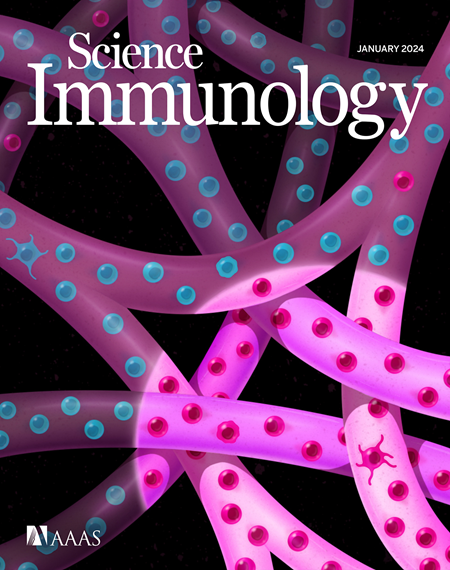RORγt上调DP胸腺细胞中RAG基因的表达,以扩大Tcra的细胞群
IF 17.6
1区 医学
Q1 IMMUNOLOGY
引用次数: 0
摘要
当胸腺细胞从 CD4-CD8- 双阴性(DN)过渡到 CD4+CD8+ 双阳性(DP)阶段时,重组活化基因(RAG)的表达会增加,但转录上调的生理重要性和机制尚不清楚。在这里,我们发现重组激活基因抗沉默子(DPASE)中的一个DP特异性成分会引起DP胸腺细胞中RAG表达的升高。缺乏DPASE的小鼠DP胸腺细胞的RAG表达与DN胸腺细胞相当,但由于次生Vα-Jα重排效率低下,这只能支持部分Tcra核系。这些数据表明,RAG 的上调是完整的 Tcra 基因库所必需的,而且 RAG 的表达在淋巴细胞发育过程中会进行微调,以满足不同抗原受体位点的要求。我们进一步发现,转录因子RORγt通过与DPASE结合来指导DP胸腺细胞中RAG的上调,RORγt通过与Tcra增强子结合来影响Tcra基因库。这些数据以及之前的研究表明RORγt通过调节DP胸腺细胞的增殖和存活来控制Tcra的重排,揭示了RORγt协调多种途径支持Tcra汇集的形成。本文章由计算机程序翻译,如有差异,请以英文原文为准。
RORγt up-regulates RAG gene expression in DP thymocytes to expand the Tcra repertoire
Recombination activating gene (RAG) expression increases as thymocytes transition from the CD4−CD8− double-negative (DN) to the CD4+CD8+ double-positive (DP) stage, but the physiological importance and mechanism of transcriptional up-regulation are unknown. Here, we show that a DP-specific component of the recombination activating genes antisilencer (DPASE) provokes elevated RAG expression in DP thymocytes. Mouse DP thymocytes lacking the DPASE display RAG expression equivalent to that in DN thymocytes, but this supports only a partial Tcra repertoire due to inefficient secondary Vα-Jα rearrangement. These data indicate that RAG up-regulation is required for a replete Tcra repertoire and that RAG expression is fine-tuned during lymphocyte development to meet the requirements of distinct antigen receptor loci. We further show that transcription factor RORγt directs RAG up-regulation in DP thymocytes by binding to the DPASE and that RORγt influences the Tcra repertoire by binding to the Tcra enhancer. These data, together with prior work showing RORγt to control Tcra rearrangement by regulating DP thymocyte proliferation and survival, reveal RORγt to orchestrate multiple pathways that support formation of the Tcra repertoire.
求助全文
通过发布文献求助,成功后即可免费获取论文全文。
去求助
来源期刊

Science Immunology
Immunology and Microbiology-Immunology
CiteScore
32.90
自引率
2.00%
发文量
183
期刊介绍:
Science Immunology is a peer-reviewed journal that publishes original research articles in the field of immunology. The journal encourages the submission of research findings from all areas of immunology, including studies on innate and adaptive immunity, immune cell development and differentiation, immunogenomics, systems immunology, structural immunology, antigen presentation, immunometabolism, and mucosal immunology. Additionally, the journal covers research on immune contributions to health and disease, such as host defense, inflammation, cancer immunology, autoimmunity, allergy, transplantation, and immunodeficiency. Science Immunology maintains the same high-quality standard as other journals in the Science family and aims to facilitate understanding of the immune system by showcasing innovative advances in immunology research from all organisms and model systems, including humans.
 求助内容:
求助内容: 应助结果提醒方式:
应助结果提醒方式:


